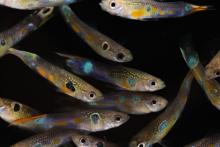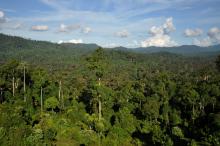UBC evolutionary biologist and Beaty Biodiversity Museum Director Wayne Maddison has received the 2010 Bruce Naylor Award. This national award, presented by the Alliance of Natural History Museums of Canada (ANHMC), recognizes exceptional contributions to the museum-based study of natural history in Canada.
Maddison heads the new Beaty Biodiversity Museum in Vancouver. The post is the latest step in a multi-faceted career as a professor, teacher and world expert on jumping spiders, a group with more than 5,000 species known to science. Maddison has published over 20 scientific papers on the taxonomy, systematics and evolution of jumping spiders, which are known for their acute vision. In 2008, he discovered dozens of new species during field work in Papua New Guinea.
“He’s not only an inspirational teacher and natural historian, but also someone who has contributed to the way that we talk about evolutionary biology,” says Sarah Otto, a colleague and Professor of Zoology at UBC.
Maddison has shared his passion for understanding evolution and biodiversity in numerous ways. He has developed some fundamental computer programs and tools used by biologists for phylogenetics, the study of evolutionary relatedness among living things. He is also one of the founders of the encyclopedic Tree of Life project (tolweb.org). With more than 10,000 web pages, this award-winning project provides information about biodiversity, the characteristics of different groups of organisms, and their evolutionary history.
“I remember paying a lot of attention to bugs, salamanders and other critters as a child, with my brother,” recalls Maddison. “When I was 13, I found an especially entrancing jumping spider. I kept it alive for months, and started learning about others. I haven't stopped since.”
Undergraduate studies at the University of Toronto were followed by a doctorate at Harvard University. From there Maddison eventually landed at the University of Arizona, where he established his credentials as an evolutionary biologist who studied jumping spiders as a way to approach scientific questions about systematics and the interrelationships of living things.
In 2003, Maddison relocated to Vancouver as a professor at UBC and was awarded a Canada Research Chair in the Departments of Zoology and Botany. At UBC, he helped spearhead the development of the Beaty Biodiversity Museum, which houses two million specimens, including one of only two blue whale skeletons on display in Canada.
“I've been associated with museums since high school, and I've often felt the joy of stumbling on important specimens in their collections. I always felt that I was sifting through treasures of the natural world,” says Maddison. “When UBC decided to consolidate our collections and open a public natural history museum, I stepped forward to help with this important effort to study biodiversity, to archive it, and to tell the public of its wonders.”
The Bruce Naylor Award is named for the former director of the Royal Tyrrell Museum of Palaeontology. Deceased in 2007, Naylor also served as president of the ANHMC.
Musqueam First Nation land acknowledegement
We honour xwməθkwəy̓ əm (Musqueam) on whose ancestral, unceded territory UBC Vancouver is situated. UBC Science is committed to building meaningful relationships with Indigenous peoples so we can advance Reconciliation and ensure traditional ways of knowing enrich our teaching and research.
Learn more: Musqueam First Nation
Faculty of Science
Office of the Dean, Earth Sciences Building2178–2207 Main Mall
Vancouver, BC Canada
V6T 1Z4


